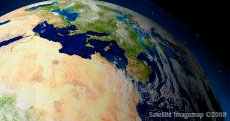 |
Wetlands exert major impacts on global biogeochemistry, hydrology, and
biological diversity. The extent and seasonal, interannual, and
decadal variation of inundated wetland areas play key roles in
ecosystem dynamics. Despite the importance of these environments in
the global cycling of carbon and water and to current and future
climate, the extent and dynamics of global wetlands remain poorly
characterized and modeled, primarily because of the scarcity of
suitable regional-to-global remote sensing data for characterizing
their distribution and dynamics.
Spaceborne microwave remote sensing
offers effective tools for characterizing wetlands since it is
particularly sensitive to surface water and to vegetation structure,
and it allows monitoring large inaccessible areas on a temporal basis
regardless of atmospheric conditions or solar illumination. Through
the use of remote sensing instruments, wetlands can be periodically
mapped and examined.
|
 |




